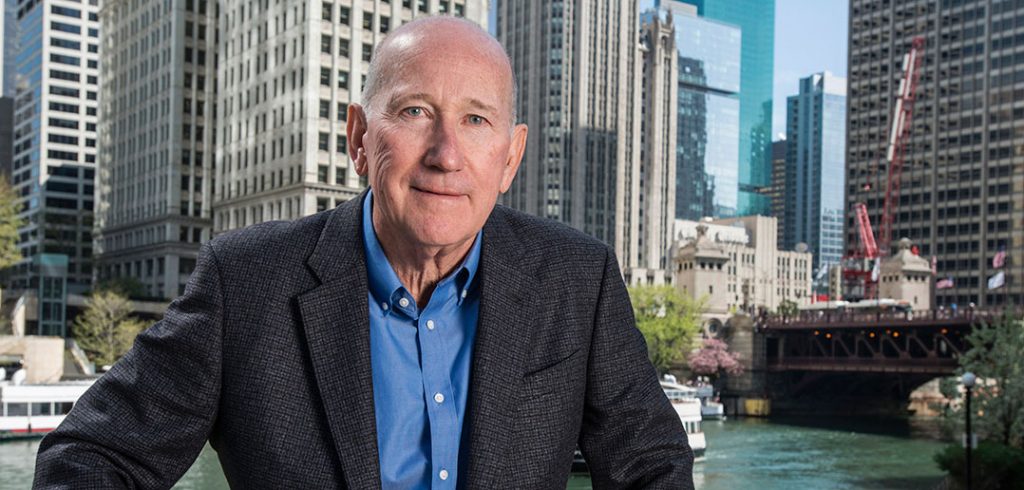Frank Cheswick, GABELLI ’70, principal of Cheswick Capital LLC, is an entrepreneur with more than four decades of experience in the chancy business of implementing ideas for new businesses. He got the idea for an obituaries website at a key point in his career. After being laid off from his job in a bank’s private equity group in 1994, he and a friend had gone into business for themselves, founding a company that helped startup companies find investors. The work made him think more acutely about his own ideas for new ventures, as well as a habit that kept him from pursuing them.
Cheswick spoke with FORDHAM magazine from his home in the Chicago area about how the idea that became legacy.com occurred to him and how, to turn it into reality, he had to go against his own instincts.
How did working with entrepreneurs spur you to pursue your own ideas?
I always had this desire to be an entrepreneur, but didn’t do that for 22 years until my friend and I went into business together, helping entrepreneurs find capital. I was exposing myself to people who actually took ideas and went somewhere with them and created businesses, and it just started bugging me—why don’t I ever do this? And then I had this kind of epiphany: I was not particularly driven by money. What drove me were the compliments for the idea.
Why did that present a problem?
When I got a new idea, I would tell my wife, my kids, my friends—anyone I could trust. The new idea inflated a balloon that I carried on my shoulder. As I confided my ideas, if I heard “You get the best ideas” or some other compliment, the balloon would dispel a little gas. The more compliments, the less need to do the hard work or risk the capital to take the idea to its conclusion. Once enough gas left the balloon, my ego was sated. Something about this insight hurt so bad I decided I had to change. I thought, what if I don’t tell my family and friends? I decided to only tell people who can move the ball forward, and to be intellectually honest about who that was. And then the next idea that hit me, just by coincidence, was legacy.com.
How did that happen?
It was 1997 and the Internet was just rounding first base and speeding towards second. My partner and I were in his car when he told me someone we knew had lost a loved one. This was someone I liked, and I considered sending flowers, but we were not that close and money was tight. I recalled that we Catholics had a condolence product called a Mass Card that was at the perfect price point for just such occasions. The problem was, they were sold primarily from the parish office, and its hours were increasingly restricted. That jogged my next thought—why not sell Mass Cards over the Internet? And that tripped another thought—why not put the whole condolence industry on the Internet? In effect, we would become the online version of the death notice.
When I forced myself to keep my mouth shut, I drew energy from the idea and the modifications and possibilities expanded. Perhaps the most exciting thing was the opportunity to smoothly handle memorial contributions that are requested in lieu of flowers. My experience was that the process was cumbersome and my good intentions often slipped through the cracks. If the death notice were on the Internet, these contributions would be a click away. In effect, this simple idea could lift the tide of memorial contributions.
Whom did you tell about it, and what happened next?
One of the first guys I went to was my local funeral director, since I was looking for the funeral directors to sell this product. He was enthusiastic about it. As I was pitching him on the company, originally called obitdetails.com, he kept getting interrupted by calls for directions to the funeral home, which gave us the idea of including directions in the online obituary.
I also told a former client from the bank, Matty Spagat, who made the initial investments that allowed us to start hiring. We met with a rising star at McKinsey & Company, Stopher Bartol, who was working with newspapers seeking to put their classifieds online. When we told him the idea, he saw it right away and came in to start the company and run it. Tribune Ventures and Gannett invested in the company, and it changed business models to sell directly to newspapers, bypassing the funeral homes. I was involved with the company just as an investor until we sold it three years ago.
Has your original lesson, about keeping mum about your ideas, stayed with you?
If I had another legacy.com-type idea I would absolutely apply that lesson again. I’ve spoken in front of few organizations and schools—and at a PechaKucha networking event—about this idea, and I’ve gotten feedback from people in the audience saying that they’re like me and they’re going to try this approach. I tell them that you’ve got to let yourself almost burst with the idea. As the pressure’s building, put your focus on who will move the ball forward. I call this presentation “The Best Idea”—the best idea I ever had wasn’t the product; it was the insight into how I operate.
Interview conducted, condensed, and edited by Chris Gosier.

